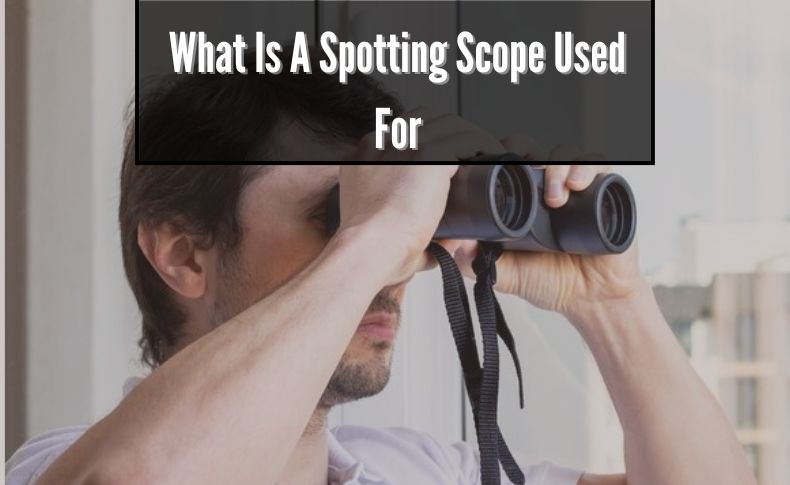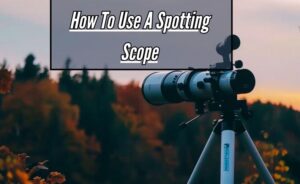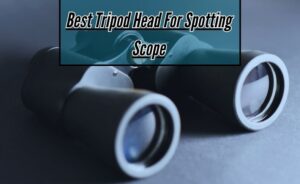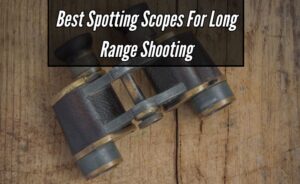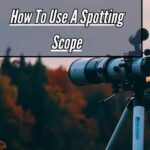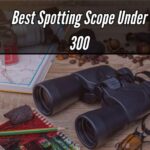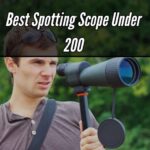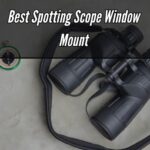Have you ever wondered how birdwatchers, nature lovers, or even sharpshooters are able to obtain a closer look at far-off objects? A spotting scope is a practical optical tool that holds the key. We shall learn what a spotting telescope is and its different applications in this investigation.
What Is A Spotting Scope Used For? A spotting scope is used to enlarge far-off objects and offer a crisper, more in-depth perspective. It is frequently used for pursuits like astronomy, target shooting, animal observation, and birdwatching because it enables users can see distant objects with greater clarity and precision.
A spotting scope is similar to a small, portable telescope made for observing the earth’s surface. It has the appearance of a little telescope yet is incredibly effective at enlarging distant objects. Outdoor enthusiasts love it because it enables them to get up close and personal with far-off wonders. Spotting scopes, which are similar to binoculars but have greater magnification capabilities, are made up of a number of lenses and prisms.
Introduction to Spotting Scopes
Spotting scopes are indispensable optical instruments that have found their place in a variety of activities, from birdwatching and wildlife observation to target shooting and astronomy.
These versatile devices provide a magnified view of distant objects, offering greater detail and clarity compared to binoculars. In this comprehensive note, we will delve into the world of spotting scopes, exploring their construction, features, applications, and tips for choosing the right one.
Optical Construction and Components
In optical construction, different parts are put together to build devices that work with light. Mirrors and prisms are important parts because they reflect light, divide light into its component colours, and focus or diverge light.
Filters are another tool used by optical systems to transmit or reject specific light wavelengths. Engineers create optical instruments for a variety of uses, such as telescopes and cameras, by precisely positioning these parts. This allows us to explore the universe and take clear, precise pictures of moments in time.
Features and Magnification
Spotting scopes come in a variety of sizes and configurations, often denoted as “X-Ymm,” where X represents the magnification power and Y represents the diameter of the objective lens in millimeters.
Common amplification ranges for spotting scopes include 15-60x or 20-80x. Higher magnification allows for better observation of distant objects, but it also requires a steadier hand or tripod to avoid image shake. Adjustable eyepieces, focus knobs, and zoom features provide users with control over their viewing experience.
Applications and Outdoor Pursuits
Spotting scopes find applications in a multitude of outdoor activities. Birdwatchers rely on them to observe intricate details of distant avian species, while wildlife enthusiasts use spotting telescopes to track elusive animals in their natural habitats. Astronomers employ them for lunar and planetary observations.
Moreover, target shooters and hunters use spotting telescopes for precision aiming and assessing shot placement at extended ranges. The versatility of spotting scopes makes them invaluable tools for a wide range of hobbies and professions.
Choosing the Right Spotting Scope
Selecting the ideal spotting scope depends on your specific needs and preferences. Factors to consider include magnification power, objective lens size, portability, and weather resistance. It’s also crucial to evaluate the quality of optics and coatings, as this significantly affects image brightness and clarity.
Budget is another important consideration, as spotting telescopes can vary widely in price. Finally, don’t forget to factor in accessories like tripods and carrying cases, which can enhance your overall spotting scope experience.
Optical Features of Spotting Scopes

Spotting scopes are versatile optical instruments that find application in various activities, including birdwatching, wildlife observation, target shooting, and even astronomy.
Their optical features play a crucial role in determining the quality and performance of these scopes. In this comprehensive note, we will explore the key optical features that define spotting scopes.
Objective Lens Diameter
The objective lens is a critical component of a spotting scope, responsible for gathering light and creating an image. The diameter of the objective lens, typically measured in millimeters, greatly affects the scope’s light-gathering ability.
A larger objective lens allows more light to enter the scope, resulting in brighter and clearer images, especially in low-light conditions. However, a larger objective lens can also make the spotting scope bulkier and heavier.
Magnification
Magnification is another vital optical feature of spotting scopes. It determines how much closer the viewed object appears compared to the naked eye.
Spotting scopes come with variable amplification, allowing users to zoom in on distant objects. It’s important to note that higher magnification isn’t always better, as it can lead to a narrower field of view and increased sensitivity to shaky hands.
Eyepiece Design
Spotting scopes come with various eyepiece designs, including straight and angled eyepieces. The choice between the two largely depends on the intended use and personal preference.
Straight eyepieces are more intuitive for beginners and are well-suited for viewing objects at eye level. Angled eyepieces, on the other hand, offer greater flexibility when it comes to adjusting the viewing angle, making them ideal for birdwatchers and astronomers.
Coatings and Prisms
Spotting scopes often feature specialized coatings on their lenses and prisms to enhance image quality. These coatings serve multiple purposes, such as reducing glare, increasing light transmission, and improving color fidelity.
Common coatings include anti-reflective coatings like fully multi-coated, multi-coated, or fully coated optics. High-end spotting scopes may also incorporate phase-corrected prisms for superior image sharpness and clarity.
Exit Pupil and Eye Relief
Exit pupil refers to the diameter of the beam of light that exits the eyepiece and enters your eye. To ensure a bright and comfortable viewing experience, the exit pupil should match the diameter of your eye’s pupil, which varies depending on lighting conditions and age.
Eye relief is another important factor, especially for eyeglass wearers, as it determines the distance between the eyepiece and your eye. A longer eye relief is essential for comfortable viewing with glasses.
Spotting Scopes in Target Shooting

Spotting scopes, a quintessential tool in the world of target shooting, serve as indispensable aids for shooters of all skill levels.
Whether you’re a competitive marksman or a recreational shooter, these precision instruments play a pivotal role in enhancing your accuracy and overall shooting experience. In this comprehensive note, we will delve into the various aspects of spotting scopes in target shooting.
Precision Optics for Enhanced Clarity
Spotting scopes are renowned for their exceptional optical quality. Equipped with high-quality lenses and prisms, these scopes provide unparalleled clarity and magnification. They allow shooters to observe their targets with remarkable detail, even at long distances.
This optical clarity is particularly crucial in target shooting, where precision is paramount. Shooters can spot even the tiniest imperfections on their targets, aiding in precise shot placement.
Target Identification and Monitoring
In target shooting, being able to identify and monitor the target is crucial for success. Spotting scopes offer shooters the ability to zoom in on the target and evaluate their shots with precision.
They allow shooters to track the movement of the bullet holes on paper targets or easily spot hits on steel targets at extended ranges. This real-time feedback is invaluable for making necessary adjustments to windage and elevation, ultimately improving shooting accuracy.
Spotting Hits and Misses
One of the primary functions of spotting scopes in target shooting is to help shooters distinguish between hits and misses.
Whether you’re participating in competitive shooting or simply honing your skills at the range, the ability to quickly spot where your shots land is essential for assessing your performance and making necessary corrections. Spotting scopes eliminate the need for constant trips to the target, saving time and effort.
Environmental Conditions and Wind Assessment
Target shooters are often challenged by ever-changing environmental conditions, particularly wind. Spotting scopes assist shooters in gauging wind speed and direction at different distances.
By observing mirage patterns and how they affect the target image, shooters can make more informed decisions about windage adjustments. This skill is crucial for precision shooting, as even a slight wind can significantly impact the trajectory of a bullet over long distances.
Versatility and Portability
Modern spotting scopes are designed with versatility and portability in mind. They come in various sizes and configurations, from compact and lightweight models suitable for field use to larger, more powerful scopes for benchrest shooting.
Many spotting telescopes are also compatible with accessories such as smartphone adapters and digiscoping kits, allowing shooters to capture and record their shots for analysis and sharing.
Choosing the Right Spotting Scope for Your Needs
When it comes to choosing a spotting scope, it’s essential to consider various factors to ensure you get the right tool for your specific needs.
A spotting scope is a valuable optical instrument used for various outdoor activities, such as birdwatching, hunting, wildlife observation, and even astronomy. To make an informed decision, you should take the following factors into account.
Magnification and Objective Lens Diameter:
The first consideration when choosing a spotting scope is the magnification and objective lens diameter. Magnification determines how close the image will appear, while the objective lens diameter determines the amount of light the scope can gather.
For general-purpose use, a spotting telescope with a amplification of 20-60x and an objective lens diameter of 60-80mm is a good choice. However, if you need more portability, opt for a compact model with a smaller objective lens.
Quality of Optics:
The quality of the optics is paramount for a clear and sharp image. Look for spotting scopes with high–quality, fully multi-coated lenses and premium glass materials.
Brands like Swarovski, Zeiss, and Leica are renowned for their exceptional optics. While they may come with a higher price tag, the investment is worth it for those who demand superior image quality.
Durability and Weather Resistance:
Consider where and how you’ll be using your spotting scope. If you plan to venture into rugged outdoor environments or frequently experience adverse weather conditions, choose a scope with robust construction and weatherproof features. Features like waterproofing and fog-proofing will ensure your scope can withstand the elements.
Size and Portability:
The size and weight of the spotting scope can significantly impact your outdoor experience. Compact and lightweight scopes are ideal for backpacking and hiking, while larger scopes with tripod adaptability are better suited for stationary use, such as birdwatching from a fixed location. Balance your need for portability with the desired image quality to find the right fit for your activities.
Price and Budget:
Spotting scopes come in a wide range of price points. While premium brands offer top-notch quality, there are also budget-friendly options that can provide decent performance for hobbyists. Set a realistic budget based on your needs and expectations, and consider saving up for a high-quality scope if you plan to use it extensively.
Spotting Scopes in Outdoor Activities

Spotting scopes are indispensable tools for outdoor enthusiasts, offering a range of benefits across various activities. These precision optical instruments are designed to provide high-magnification, long-range viewing, making them essential companions for birdwatching, hunting, wildlife observation, and more.
In this comprehensive note, we’ll explore the versatility of spotting scopes in outdoor activities, emphasizing their significance in enhancing the overall experience.
Birdwatching Bliss:
For avid birdwatchers, spotting scopes are like a window to the avian world. These scopes offer exceptional magnification and clarity, allowing enthusiasts to observe even the most elusive birds in intricate detail.
Birders can easily identify species, study plumage patterns, and enjoy close encounters with their feathered friends. Spotting scopes are lightweight and portable, making them ideal for extended birdwatching outings.
Hunting Advantages:
Hunters rely on spotting scopes for scouting and target identification. These scopes enable hunters to scan vast landscapes, helping them spot game from a distance and plan their approach strategically.
The high-quality optics of spotting scopes ensure sharp and bright images, even in low-light conditions, aiding hunters during dawn and dusk hunts. Additionally, their durability and weatherproofing make them suitable for rugged outdoor conditions.
Wildlife Observation:
Spotting scopes are invaluable tools for wildlife enthusiasts and researchers. Whether observing elusive mammals, tracking the movements of large herbivores, or documenting the behavior of predators, these scopes provide unparalleled clarity and detail.
Researchers can use them to gather data without disturbing animals, contributing to conservation efforts and scientific knowledge.
Target Shooting Precision:
In the realm of competitive shooting and long-range target practice, spotting scopes play a pivotal role. Shooters use them to spot their shots on targets at extended distances, ensuring accuracy and consistency in their aim.
Spotting telescopes with reticle options offer even greater precision, helping shooters adjust their aim for windage and elevation. These scopes are essential for honing marksmanship skills.
Astronomy Beyond:
While primarily used for terrestrial observations, spotting scopes can also provide entry-level opportunities for stargazing and celestial exploration.
With the right adapters, they can be used for basic astronomical observations, such as observing the Moon’s craters and surface details, or tracking the movement of planets like Jupiter and Saturn. While not a replacement for dedicated telescopes, spotting telescopes offer a versatile way to dip one’s toes into the world of amateur astronomy.
Conclusion
In conclusion, a spotting scope is a flexible optical tool that has a wide range of applications in many outdoor hobbies and professional disciplines. A spotting scope can provide you improved clarity and magnification to examine faraway things with accuracy, whether you’re an avid birdwatcher, hunter, nature enthusiast, or scientist.
Because of its small size and portability, it is a crucial instrument for outdoor activities, wildlife monitoring, target shooting, and scientific research. A spotting telescope is a must-have accessory for anyone looking to get a closer look at the wonders of the natural world since it can zoom in on distant objects, revealing a world of detail and discovery.
Frequently Asked Questions (What Is A Spotting Scope Used For)
How does a spotting scope differ from a telescope?
Although they may appear to be similar, a spotting scope and a telescope have different uses. Comparable to a portable telescope, a spotting scope is mostly used for terrestrial viewing activities like wildlife observation and birdwatching. It offers a close-up look at ground-level items. A telescope, on the other hand, is designed for stargazing and provides strong magnification for celestial objects such as planets, stars, and galaxies.
A spotting scope usually has a lower magnification and a larger field of vision, which makes it simpler to track moving subjects on Earth, even though both employ lenses or mirrors to gather light. However, because of their larger amplification, telescopes are more appropriate for seeing far-off celestial objects in the night sky.
What features should I look for in a spotting scope?
Consider important elements that fit your demands when selecting a spotting scope. Select one with superior optical quality, such as premium glass lenses, to ensure crisp, clear images. Selecting a magnifying power that fits your seeing needs is essential; these usually range from 20x to 60x.
Aim for a scope with a larger objective lens size, such as 60mm to 80mm, as this will gather more light and improve brightness. If you plan to transport the scope outside, take into account its weight and size in terms of portability. Construction that is both fog- and waterproof guarantees longevity in a range of weather scenarios. Furthermore, features like slanted viewing and adjustable eyepieces can improve comfort when used for extended periods of time.
Can I use a spotting scope for stargazing?
Spotting scopes can be used for stargazing, albeit its primary purpose is terrestrial viewing. However, they are not the best for in-depth examinations of astronomical objects due to their smaller aperture size and lower amplification when compared to telescopes.
You may be able to see the moon, planets, and brighter stars with a spotting scope, but fainter celestial objects like galaxies or nebulae might not be as visible. Purchasing a telescope made for astronomy might be a better option if you enjoy stargazing. Larger apertures and higher magnification make telescopes more suitable for in-depth exploration of the night sky’s wonders.
Are spotting scopes waterproof?
Yes, a lot of spotting scopes have waterproof designs. This is an essential characteristic for outdoor pursuits where exposure to rain or wetness is frequent, such as hunting, birdwatching, or nature observation. By preventing water damage to the interior parts of the spotting scope, waterproofing helps to ensure its longevity and durability.
Furthermore, fogging brought on by temperature variations is often avoided by using waterproof spotting scopes, which are also frequently fog-proof. To be sure it satisfies your needs for outdoor use in a variety of weather situations and to confirm its waterproof certification, it is imperative that you review the specs of each spotting telescope type.
What is the best magnification for a spotting scope?
The purpose for which you plan to utilize a spotting scope will determine which magnification is ideal. A 20x–60x magnification spotting telescope is appropriate for common uses such as wildlife observation, birdwatching, and scenic gazing. Because lower amplifications offer a larger field of view, it is simpler to find and follow moving objects.
While higher magnifications are great for seeing details that are far away, they can also cause a reduction in brightness and a restricted field of view, particularly in low light. To guarantee a satisfying viewing experience catered to your unique requirements and tastes, it is crucial to balance amplification with elements including optical quality, objective lens size, and climatic circumstances.
Are spotting scopes only for professional use?
Spotting scopes are useful instruments that may be used by both professionals and amateurs; they are not just for use in the field. Anyone interested in nature, animals, or outdoor activities can use a spotting telescope; however, experts like birdwatchers, hunters, and naturalists frequently use them for their in-depth observations.
Spotting telescopes are excellent for observing wildlife, birds, landscapes, and even just stargazing since they provide enlarged views of far-off objects. Their availability in diverse sizes, magnifications, and price points enables them to cater to a broad spectrum of users. A birdwatching telescope may improve your outdoor experiences and let you get closer to the beauties of nature, regardless of your level of experience.

